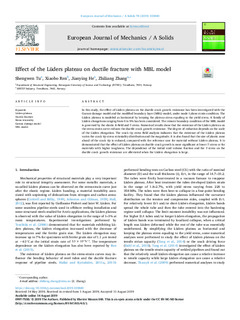| dc.contributor.author | Tu, Shengwen | |
| dc.contributor.author | Ren, Xiaobo | |
| dc.contributor.author | He, Jianying | |
| dc.contributor.author | Zhang, Zhiliang | |
| dc.date.accessioned | 2019-08-28T12:55:53Z | |
| dc.date.available | 2019-08-28T12:55:53Z | |
| dc.date.created | 2019-08-17T13:55:51Z | |
| dc.date.issued | 2019 | |
| dc.identifier.issn | 0997-7538 | |
| dc.identifier.uri | http://hdl.handle.net/11250/2611454 | |
| dc.description.abstract | In this study, the effect of Lüders plateau on the ductile crack growth resistance has been investigated with the Gurson damage model and the modified boundary layer (MBL) model, under mode I plane strain condition. The Lüders plateau is modeled as horizontal by keeping the plateau stress equaling to the yield stress. A family of Lüders elongations ranging from 0 to 5% has been considered. The remote boundary condition of the MBL model is governed by the elastic K-field and T-stress. Numerical results show that the existence of the Lüders plateau on the stress-strain curve reduces the ductile crack growth resistance. The degree of reduction depends on the scale of the Lüders elongation. The crack tip stress field analysis indicates that the existence of the Lüders plateau varies the crack tip stress striaxiality distribution and the magnitude. It is also found that the size of plastic zone ahead of the crack tip is reduced, compared with the reference case for material without Lüders plateau. It is demonstrated that the effect of Lüders plateau on ductile crack growth is more significant at lower T-stress or for materials with higher toughness. The dependence of the initial void volume fraction and the T-stress on the ductile crack growth resistance are alleviated when the Lüders elongation is large. | nb_NO |
| dc.language.iso | eng | nb_NO |
| dc.publisher | Elsevier | nb_NO |
| dc.rights | Attribution-NonCommercial-NoDerivatives 4.0 Internasjonal | * |
| dc.rights.uri | http://creativecommons.org/licenses/by-nc-nd/4.0/deed.no | * |
| dc.title | Effect of the Lüders plateau on ductile fracture with MBL model | nb_NO |
| dc.type | Journal article | nb_NO |
| dc.type | Peer reviewed | nb_NO |
| dc.description.version | publishedVersion | nb_NO |
| dc.source.journal | European journal of mechanics. A, Solids | nb_NO |
| dc.identifier.doi | 10.1016/j.euromechsol.2019.103840 | |
| dc.identifier.cristin | 1716677 | |
| dc.relation.project | Norges forskningsråd: 228513 | nb_NO |
| dc.description.localcode | © 2019 The Authors. Published by Elsevier Masson SAS. This is an open access article under the CC BY-NC-ND license (http://creativecommons.org/licenses/BY-NC-ND/4.0/). | nb_NO |
| cristin.unitcode | 194,64,45,0 | |
| cristin.unitname | Institutt for konstruksjonsteknikk | |
| cristin.ispublished | true | |
| cristin.fulltext | postprint | |
| cristin.qualitycode | 1 | |

